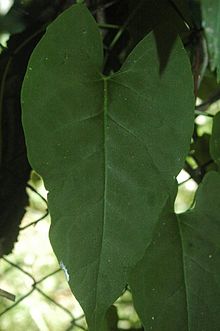| Reynoutria multiflora | |
|---|---|

| |
| Chinese knotweed | |
| Scientific classification | |
| Kingdom: | Plantae |
| Clade: | Tracheophytes |
| Clade: | Angiosperms |
| Clade: | Eudicots |
| Order: | Caryophyllales |
| Family: | Polygonaceae |
| Genus: | Reynoutria |
| Species: | R. multiflora |
| Binomial name | |
| Reynoutria multiflora (Thunb.) Moldenke | |
| Synonyms | |
| |
Reynoutria multiflora (syn. Fallopia multiflora and Polygonum multiflorum) is a species of flowering plant in the buckwheat family Polygonaceae native to central and southern China. It is known by the English common names tuber fleeceflower and Chinese (climbing) knotweed. It is known as he shou wu (何首烏) in China and East Asia. Another name for the species is fo-ti, which is a misnomer.
It can be difficult to prevent the spread of this vine and to remove it once established. The leaves are thin and fragile but the stems, although narrow in diameter, can be very strong.
Description
Reynoutria multiflora is a herbaceous perennial vine growing to 2–4 m (6 ft 7 in – 13 ft 1 in) tall from a woody tuber. The leaves are 3–7 cm (1.2–2.8 in) long and 2–5 cm (0.79–1.97 in) broad, broad arrowhead-shaped, with an entire margin. The flowers are 6–7 mm (0.24–0.28 in) diameter, white or greenish-white, produced on short, dense panicles up to 10–20 cm (3.9–7.9 in) long in summer to mid-autumn. The fruit is an achene 2.5–3 mm (0.098–0.118 in) long.
In folk belief
In Chinese folklore, it is believed that the root of he shou wu (何首烏, Reynoutria multiflora) can, after a thousand years, transform into a human form, either as a child or an old person. It is also said that Zhang Guolao, one of the Eight Immortals, achieved immortality by consuming the essence of he shou wu.
Two types of stories often revolve around the essence of he shou wu. In one version, a monk or Taoist acquires a human-shaped he shou wu and instructs a disciple to cook it. The disciple, tempted, secretly tastes it, becomes immortal, and disappears. In the other version, the essence of he shou wu takes on human form and accompanies a woman. Finding his behavior suspicious, the woman sews a thread into him. The following day, she traces the thread and finds it attached to a he shou wu root, from which a human shape is growing.
Traditional medicine
Reynoutria multiflora is listed in the Chinese Pharmacopoeia and is one of the most popular perennial traditional Chinese medicines. Caution must be taken, however, as overconsumption can lead to toxicity-induced hepatitis.
Chemistry
More than 100 chemical compounds have been isolated from Reynoutria multiflora, and the major components have been determined to be stilbenes, quinones, flavonoids, and others. Its extract contains a stilbene glycoside.
See also
References
- ^ "Reynoutria multiflora (Thunb.) Moldenke", Plants of the World Online, Royal Botanic Gardens, Kew, retrieved 2019-02-25
- ^ "Fallopia multiflora". Flora of China.
- "Reynoutria multiflora". Germplasm Resources Information Network. Agricultural Research Service, United States Department of Agriculture. Retrieved 21 December 2017.
- NRCS. "Polygonum multiflorum". PLANTS Database. United States Department of Agriculture (USDA). Retrieved 12 October 2015.
- Bounda, G. A; Feng, Y (2015). "Review of clinical studies of Polygonum multiflorum Thunb. And its isolated bioactive compounds". Pharmacognosy Research. 7 (3): 225–236. doi:10.4103/0974-8490.157957. PMC 4471648. PMID 26130933.
- "Fo-ti". WebMD.
- Lin, Longfei; Ni, Boran; Lin, Hongmei; Zhang, Miao; etc. (15 January 2015). "Traditional usages, botany, phytochemistry, pharmacology and toxicology of Polygonum multiflorum Thunb.: A review". Journal of Ethnopharmacology. 159: 158–183. doi:10.1016/j.jep.2014.11.009. PMC 7127521. PMID 25449462.
- "Polygonum multiflorum and liver reactions". MHRA. 2006. Archived from the original on 2014-12-05.
- "He-shou-wu (Polygonum multiflorum) potted plant, organic". Strictly Medicinal Seeds. 2016-11-22. Retrieved 2021-03-31.
- ^ 民間文學 (in Chinese). 中國民間文藝出版社. 2000. p. 30.
- Jung, KA; Min, HJ; Yoo, SS; Kim, HJ; Choi, SN; Ha, CY; Kim, HJ; Kim, TH; et al. (2011). "Drug-Induced Liver Injury: Twenty Five Cases of Acute Hepatitis Following Ingestion of Polygonum multiflorum Thunb". Gut and Liver. 5 (4): 493–9. doi:10.5009/gnl.2011.5.4.493. PMC 3240794. PMID 22195249.
- Tang, J (2007). "Antioxidant activity of stilbene glycoside from Polygonum multiflorum Thunb in vivo". Food Chemistry. 104 (4): 1678–1681. doi:10.1016/j.foodchem.2007.03.022.
- Grech J. N., Li Q., Roufogalis B.D., Duke C.C. Novel Ca2+-ATPase Inhibitors from the Dried Root Tubers of Polygonum multiflorum. J Nat Prod-Lloyda 57(12), 1682-1687, 1994.
External links
- Reynoutria multiflora: Images & occurrence data from GBIF
- line drawing, Flora of China Illustrations vol. 5, fig. 259, 3-5
- Ho-shou-wu: What's in an herb name?
| Taxon identifiers | |
|---|---|
| Reynoutria multiflora | |
| Fallopia multiflora |
|
| Polygonum multiflorum | |